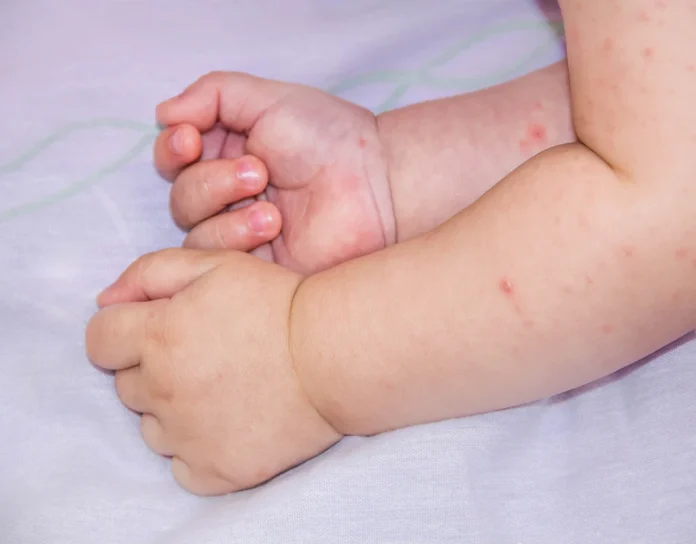Babies and toddlers can be (or become) sensitive to certain substances and foods, which can stimulate their immune system to causing an allergic response.
The allergen is the substance that causes the immune system to have an allergic reaction. In an allergic reaction, the immune system believes that the allergen is attacking the body, so the body produces antibodies against the allergen. The antibodies cause a series of reactions in the body which cause the allergic reaction symptoms.
Allergies are not usually dangerous in most cases, just irritating and bothersome for the baby or toddler. The exception to this is the serious form of an allergic reaction anaphylaxis.
Common causes of allergic rashes
Some common causes of allergic rashes in babies and children are:
- Cellulitis – this is a skin infection that is caused by a bacteria. There is no obvious break in the skin, cellulitis occurs for reasons unknown but could be due to lowered immunity
- Chemicals – any type of chemical, from those used in baby products, to environmental chemicals (pollution) can cause an allergic reaction in some babies and toddlers
- Contact dermatitis – anything can cause an allergic reaction if it is touched. Contact dermatitis occurs when a child touches an allergen, which then causes a rash
- Eczema – is a chronic allergic rash that commonly affects children in families with a history of allergies. Eczema rash is usually dry, itchy and often painful
- Food allergy – quite commonly, food allergies in babies occur due to the ingestion of food that makes them allergic. The most common food allergens are: chocolate. eggs, fish, milk, nuts (especially peanuts), seafood, spices, strawberries. The allergic reaction can occur from ingestion or even just contact with the food
- Head lice – this is a very common condition in young children. Head lice are insects that lay eggs on the hair. They spread easily and make the scalp very itchy
- Medications – any type of medication can cause an allergic reaction (especially rash) in a baby or toddler, with penicillin being the most common allergen in this category
- Nappy rash – this occurs when the skin becomes red, irritated. Nappy rash is an allergic reaction to the nappy,urine and stools. It occurs when the nappy is not changed often enough
- Plants – a number of plants are known to produce an allergic reaction, in particular, stinging nettle and poison ivy. Any type of plant or grass can be a potential allergen for a baby or toddler
Symptoms of allergies
The symptoms of an allergic reaction will be different depending on the type of allergen and whether it was ingested, inhaled or touched the skin:
Possible symptoms if the allergen affects the skin
- Blistering – these can be formed on the skin together with the other skin symptoms
- Itching – the skin can become very itchy, especially if a rash is present
- Rash (urticaria) – this will most often occur when the skin is affected
- Welts – these are raised swellings on the skin which are inflamed
Possible symptoms if the allergen is ingested
- Fatigue – it requires a lot of energy for the body to “fight” an allergen
- Fever – sometimes a mild fever can occur
- Headache – another allergic reaction
- Joint pains – another allergic reaction
- Rash (urticaria) – this can occur on any part of the body, but more likely on the trunk or neck
Possible symptoms if the allergen is inhaled
- Fatigue – it requires a lot of energy for the body to “fight” an allergen
- Headache – another allergic reaction
- Rash (urticaria) – this can occur on any part of the body, but more likely neck or chest area
- Wheezing – breathing properly may be impaired as the air sacs in the lungs become constricted
Treatment of allergies
Allergies are treated through a number of ways:
- Aloe vera lotion – the aloe vera plant is really beneficial to help calm irritated, red and inflamed skin
- Avoid the allergen – as much as possible, find out what the baby is allergic to and ensure it is avoided
- Calamine lotion – this is often recommended to reduce the inflammation of a rash
- Cold compress – this is a useful way to reduce the inflammation of a rash
- Eczema or dermatitis cream – these will help soothe the itchy skin. These creams usually contain calendula which is a potent skin soother
- Have allergy tests – this will help to determine what allergens are causing the allergic reaction
- Medications – if the allergic reaction is moderate to severe, antihistamine medications may be prescribed
Extreme allergies (anaphylaxis)
In rare cases, a baby or toddler may have a very severe reaction to an allergen (the substance that creates the allergic reaction) and this can be very dangerous.
A severe allergic reaction is known as anaphylaxis, which can culminate in anaphylactic shock if treatment is not given immediately (which is either with antihistamines or adrenaline).
Anaphylaxis impairs breathing ability as well as causing a number of distressing symptoms for the baby (or toddler), such as:
- Severe breathing difficulties
- Quick drop in blood pressure
- Collapsing
If a baby (or toddler) experiences the above very serious symptoms, they need urgent emergency medical assistance. Call an ambulance on 000.
References
- Kids health information: rashes. The Royal Children’s Hospital, Australia. Accessed 6 July 2024
- Newborn skin: Part 1, common rashes. American Academy of Family Physicians | AAFP. Accessed 6 July 2024
- Rash – child under 2 years information. Mount Sinai, USA. Accessed 6 July 2024
Last reviewed and updated: 6 July 2024


